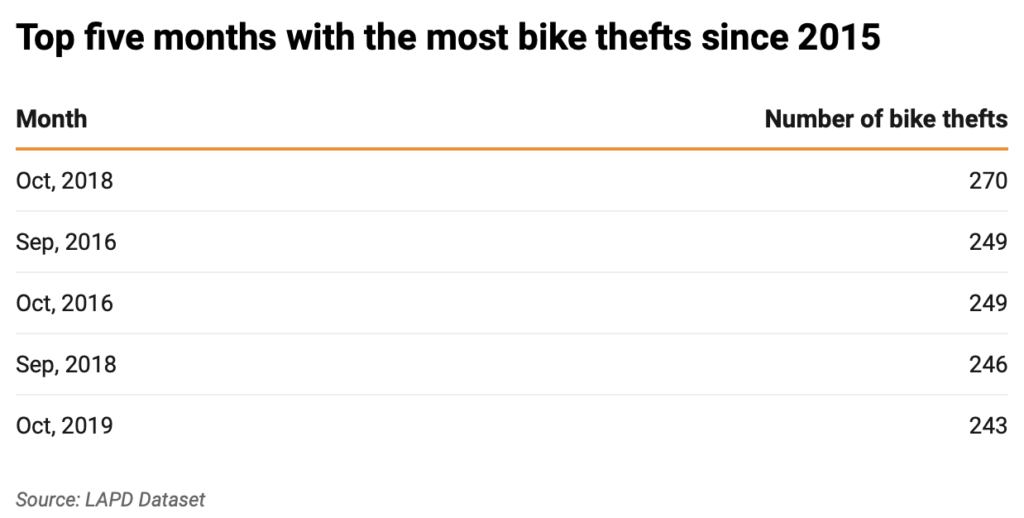Fall means bike theft season in Los Angeles

Last year, USC student Josh Sanchez rode his bicycle to campus each day. But since moving to a University Park apartment for his senior year, he has been trekking by foot. Just a week after returning, Sanchez’s lime green ride was stolen.
“Somebody came into our yard because the gate was left open and they just took it. One night it was there and the next morning it was not,” Sanchez said. “I used to be more mobile but now it takes me much longer to get places.”
Sanchez is far from alone—in the city or in his community. From Jan. 1–Aug. 15 of this year, 1,135 bikes were reported stolen in Los Angeles. Based on past patterns, that number is likely to spike in the coming months.

Since 2015, bike theft in Los Angeles has surged in the fall. From 2015 to 2019, the peak occurred in October (October and September tied in 2016). For the past two years, the high point was in September.
School in session
Bike theft numbers are likely artificially low, as publicly available Los Angeles Police Department data only counts thefts actually reported. Many people may not call police for a missing two-wheeler, either because of time constraints, or because they do not expect doing so will help with recovery.
Still, the annual fall rise in thefts indicates that the increase may be tied to the resumption of school, in particular the return of college students. From Jan. 1, 2015–Aug. 15, 2022, a total of 2,062 bicycles were reported stolen in University Park, where the USC campus is located and where many of its students reside. That is the highest count of any neighborhood in the city of Los Angeles.

The second-highest number of thefts occurred in dense Downtown, followed by Venice, a well-known cycling hub. The fourth-most victimized community in that period was Sawtelle, where many UCLA students live.
In July–August of 2021, when most schools and universities were on summer break, there were 333 reported bicycle thefts in the city. As students returned in the following two months, the number ballooned to 423, a 27.8% increase. In that September–October timeframe, University Park and Downtown each recorded 50 thefts. Sawtelle ranked fourth with 25 thefts. Westwood, where UCLA is located, was sixth with 19 thefts.
USC Department of Public Safety Chief David Carlisle said he is not surprised by the pattern of a fall increase. Bicycle thefts are the most common crime on campus (crimes reported to the DPS are included in LAPD data).
“The highest numbers occur at the beginning of the semester, during the fall. That’s when students return to campus,” he said. “We get 3,000 freshmen every year and bicycles are a very popular form of transportation.”

Carlisle said that as the semester goes on, students begin to realize how vulnerable they are to bike thefts and take additional precautions, such as securely fastening bikes to racks with U-locks, or keeping them indoors.
“As the word spreads about how to take actions to help from being a victim oneself, we see the numbers go down,” he said.
Other missing wheels
Bicycles are not the only vehicles that go missing near USC. In April, Crosstown reported on a rise in electric scooters stolen in the vicinity of the university.
While many bikes go missing, some are recovered. Carlisle suggests that students register their bicycles with the DPS. Indeed, in August, five bikes that were registered were located in Santa Monica, where a thief had tried to sell them.
Angelenos can register their rides with the Bike Index, a national registry that the LAPD has partnered with. Registered bicycles that are stolen and recovered can be traced back to the original owners.
Sometimes, the best way to thwart a theft is prevention. Ted Rogers, the editor of the blog BikinginLA and a former board member of the Los Angeles County Bicycle Coalition, said he takes measures to keep his bike safe.
“I’ve been known to walk my bike into stores just so I don’t have to lock it up,” he said. “Never lock your bike to a sign because signs can be unbolted and taken away. Never lock your bike to a small tree because those have been known to be pulled out of the ground.”
How we did it: We examined publicly available LAPD data on bike thefts from Jan. 1, 2015–Aug. 15, 2022. For neighborhood boundaries, we rely on the borders defined by the Los Angeles Times. Learn more about our data here.
LAPD data only reflects crimes that are reported to the department, not how many crimes actually occurred. In making our calculations, we rely on the data the LAPD makes publicly available. LAPD may update past crime reports with new information or recategorize past reports. Those revised reports do not always automatically become part of the public database.
Want to know how your neighborhood fares? Or simply just interested in our data. Email us at askus@xtown.la.






